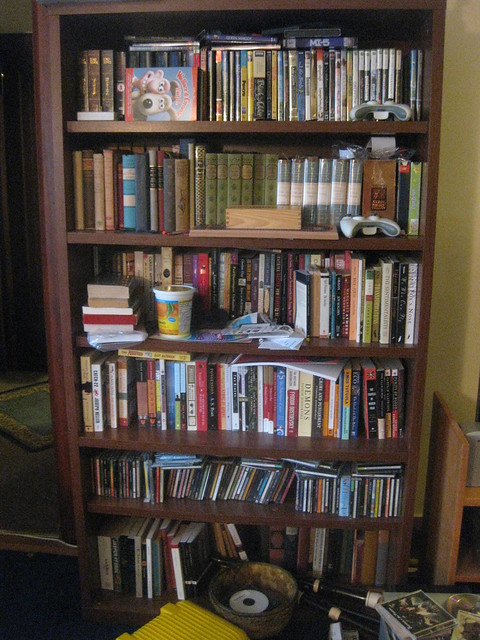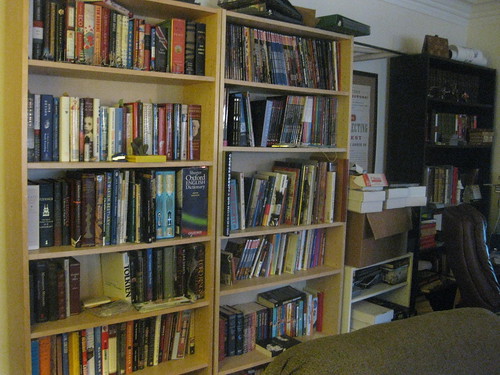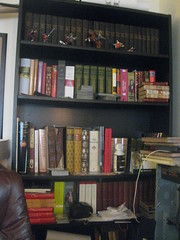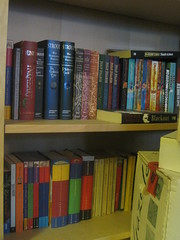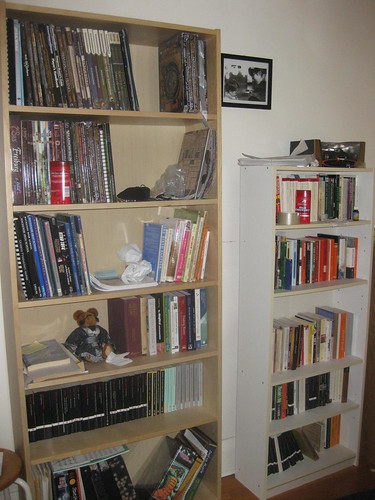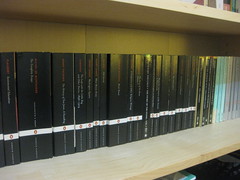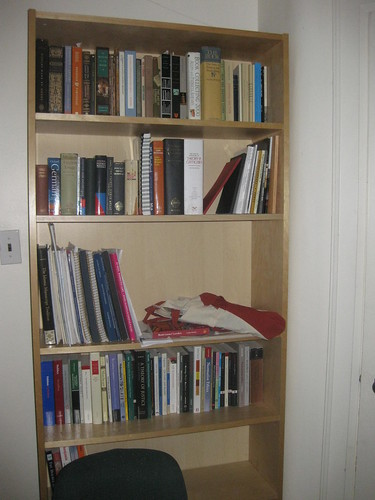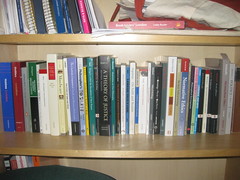November 15, 2010
A Tour Around My Library
I’ve been tinkering with LibraryThing this morning because it strikes me as a tool made for people like me. Actually, I got an email almost exactly a year ago from Library Thing’s founder Tim Spalding offering to move heaven and earth to get me to use the service, so apparently I’m not the only one who thinks it’s the Tool For Me. After a couple hours of data entry and flailing, however, I am bewildered. I’m still not clear what I should be doing with it. I thought once I had all my books listed some kind of use or purpose might become clear, but when I ran into the 200-book limit of the free account I gave up and bailed.
Even the few books listed so far look wrong to me, like books I don’t own with only the most symbolic relevance to my actual shelves. I’m sure this is something that can be fixed with effort as I clean up ISBNs and covers, but there’s more to it than that. I think my “collection” might be too much of a mess to catalogue like this, or maybe just my collecting habits (which do, yes, run towards hoarding). Certainly my shelving and sorting regime is eccentric. It isn’t messy (well, okay, it is) or disorganized, in fact I’ve got every last book shelves exactly where I want it. Sub-collections, groupings and pairings mean a lot to me. But there’s a gradient, a volatility, a flexibility I enjoy that makes labeling difficult. I moved three months ago from a place I’d lived in for five solid years to a bigger, much more book-friendly space. To this day I have not unpacked several boxes of books because I can’t decide where to put them. Until exactly the right placing presents itself, I’d sooner keep them in boxes.
But enough of the words. If the internet has taught us nothing else, it has revealed that bookshelves are better seen than described. Mine aren’t works of art (I’m aesthetically and artistically barren), but I feel they explain my collection better than LibraryThing can.
This is a typical Charlotte’s Book Shelf. A disaster, yes. But look closer.
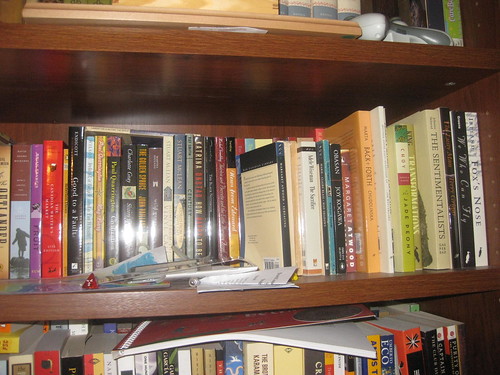
Canadian Literature, Trade Paperback (Partial)
In fact, the shelf houses several sub-collections. The top is Old Valuable Books of No Particular Subject (including a 6-volume Oxford Illustrated Jane Austen and a 1st edition Once and Future King by T.H. White in dust jacket). Next, pictured here (left), is Canadian Literature, Trade Paperbacks – which is to say, minus hardcovers and mass market editions (which are grouped elsewhere). Below that we have Contemporary Literature, Trade Paperbacks stacked in front of (and quite obscuring) Literary Non-Fiction, Paperbacks (below). Are you still with me? Good.
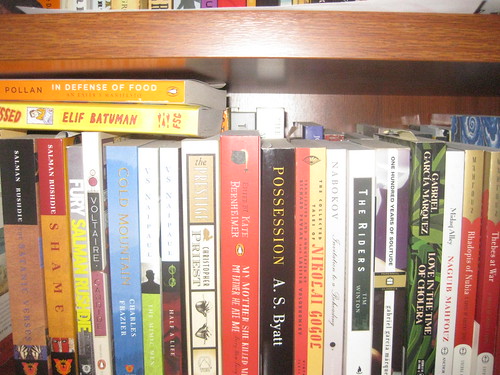
Contemporary Literature, Trade Paperback, Partial
Further ’round the room things got more complicated. I have one entire bookcase devoted to hardcovers, and I’m still not clear exactly how to order them, so I went with the unusual tactic of shelving by preference. That is, my Favourite Hardcover Novels are on top, followed by my Favourite Hardcover Non-Fiction Titles (including my becoming-unwieldy sub-collection of Robertson Davies reference works). Below that we have Assorted Books On Magic Which Are Too Big To Shelve Alsewhere (including Plato’s Complete Works and a Shorter Oxford English Dictionary – not strictly books on the occult, but if you think creatively enough it fits), and taller pieces of my husband’s Tolkien collection, which continues on the next shelf.
A note on my husband’s books: he doesn’t have many. When we started dating I made it clear I was a book collector, but I don’t think he realized he the gravity of the situation until we moved in together and he found he was moving into a library. Whatever impulses he might have had to buy books were quickly and firmly quashed by pragmatism. Who needs to buy books when you live in a library? It would be cheaper this way. To his credit, he has not (yet) become a spouse who demands the collection be culled. Much.
My collection of Alexandre Dumas is actually much less well-ordered than you’d think. It had the misfortune of being unloaded next to the computer, and next-to-the-computer detritus inevitably joined my little Musketeers and Cardinal’s Men up there.
The Young Adult Literature, on the other hand, came together just fine. Of course, half of it seems to be missing. What does this say about my friends and family that this is what is most frequently borrowed from my shelves?
I am a big one for “prioritizing” my books. Not, like a smart lady, in terms of “read” and “unread”, but in terms of “to be shown off” and “to be hidden”. I acquire quite a lot of free books in the form of damaged discards, promos and garage sale finds which I take without discrimination, reasoning that I might need them some day, or you never know when something will come in handy. On the other hand, I don’t really want to display copies of, say, Atlas Shrugged, beat up old editions of Augustine and Defoe, Environmental Studies textbooks, or somewhat dogmatic analyses of current events like It’s the Crude, Dude or God Is Not Great. These go on bottom shelves, or are hidden in my bedroom.
But, find an empty bookshelf and find some books to fill it – if my house were a bookstore, we’d also call this “overstock”. So much of this stuff is books I just don’t know what to do with. In a fit of frustration, I started shelving these by publisher. I also discovered, to my dismay, that I have no fewer than three full shelves of back-issues of magazines – old Walruses and National Geographics mainly – things which shelve poorly and were relegated to the Shelves of Shame for their lack of spine. Sadly, this is also where my old, beat-up mass market Canadian books are. Not that they are objects of shame, but mass market editions fit poorly onto Billy bookshelves, which offer so much vertical space that they’re best filled with the taller trade paperbacks and hardcovers.
Ah, the office. Moving into the new house we harboured a fantasy that we’d have time to lock ourselves away and work on our respective intellectual pursuits. Ha! Maybe in another two years, when the 2-year-old doesn’t regard a closed door as a mortal offense. Still, I like to think my Book History collection and my husband’s Philosophy books look nice all together.
Now don’t be misled by all the empty space. I’ve boxes and boxes of books left to unpack – but I’m paralyzed with indecision right now. I don’t know where to put my piles of mass market fantasy books – they can’t very well be shelved next to Philosophy or in the the Nabokov. And surely there’s a better use of my office shelves than unloading the remaining damaged and garage-saled miscellany into it? And I tell you I don’t know where I’m going to put this 3-Volume Autobiography of Mark Twain when I get it home – it needs a shelf unto itself.
Anyway, it’s not all a giant mess. I have at least one nice, reasonably well-organized shelf. I’d better not add anything to the collection though, I’m plum out of space.
I’ve been working on a collection on The Intellectual Roots of Speculative Fiction, and this is much of it. Myths, legends, epics, retellings and early fantasies – these go here. As more arrive the contemporary genre titles get shuffled away (into oblivion – they don’t have a home yet). That’s the way of my sorting. Placeholders, like-titles, reclassified as space requires. There’s no hard-and-fast rules. I keep Crowley’s Little, Big with this History of Fantasy stuff, along side Lord Dunsany and The Worm Ouroboros. But Nalo Hopkinson and Charles de Lint will have to move on eventually – exactly why I couldn’t tell you, but they don’t belong, just yet.
I tired to denote this with overlapping categories on Library Thing, but every time I moved a book I felt pressure to change all the categories. With several thousand titles, I think this could start to become ridiculous. So I’m out, Library Thing. I tried. I’m either too organized or not organized enough for you! But thank you, and I will enjoy browsing other peoples’ libraries for the time being.
Oh, and if you’re curious – you can view my minimal Library Thing profile here. Maybe you can spot what I’m doing wrong? Meanwhile, I hope you enjoyed my more meandering tour!
November 14, 2010
Please Excuse the Mess…
… I’m renovating. I needed a WordPress theme with a wider text column, and so now we’re working out the nitty-gritty of all these other customizables. Apologies!
November 12, 2010
Book: The Art you can Take Home
I hope you will all excuse me a personal, someone saccharine post. It does run bookish, eventually. I’ve had a rough couple of months, in truth. Those of you with children will understand: kids at the younger end of the spectrum sometimes go through phases (weeks, months, years) that force a mother to suspend her own well-being for a while. Sleep and peace of mind are the two biggest casualties, though don’t consider this a complaint. They are freely sacrificed. I might be incoherent and incapable of following an idea through to its logical conclusion, but that’s small potatoes in the wide world of well-being, mental health and safety.
My daughter, Miss Margaret, has been attending daycare full-time since the beginning of September. She was barely 2 years old when she began, and she’s 28 months old now. Like it is for so many little kids, the transition was rough. Though she enjoyed her first week, once she recognized this was to be a regular thing the resistance began. The Screaming Meltdowns began, the tears and the clinging and the begging for “one more hug, just one more hug!” at drop off. We were told to expect a couple of weeks of this.
After 6 weeks of this we wondered if something was up – not only did the Screaming Meltdowns show no sign of abating, but daycare has become a taboo subject around our house. “No! No! Nuffin’!” She yells at me when I ask her how her day was. “Nuffin’ about daycare!” She refuses, at daycare, to take any of her outdoor clothes off, or put any of her belongings away. She needs them, she says, for when Mama comes back. I find out how her day was through play. I might catch her sending one of her dolls “to the baby room” when the doll yells too much. She has elaborate conversations on her fake cellphone about which kids bit her and which kids hit her. Once or twice, just before drifting off to sleep at night, she has whispered something to me like “Mama, my friends at daycare not have words.” She has never said a positive thing about the place, ever.
It has been suggested that the problem is me, that I have a “negative attitude” towards the place and Maggie “picks up” on my vibes. I disguise my opinions on the matter as best as I can, hype the place up and approach it smiling each day, but meanwhile she has become more devious in avoiding it. “Okay, Mama.” she said, resigned, one day. “I come to work with you. I work at Bob Miller.” Nice try kid. This morning: “Mama, when I start school? I go big kids room today?” “It’s the weekend!” she announced, smiling, on Wednesday. Over the last four months she has lost much of the independence we’d gained up to that point. She will no longer sleep by herself. She wakes up screaming things like “No! Not take my hat off! I want my mom!” She started wetting the bed.
Well, you know, these are some toxic vibes I give off. In any case, Maggie spends 9 hours a day, 5 days a week in daycare, so I do my best on weekends to make up for it. Two full, luxurious days of family time. One of the issues with the daycare seems to be that Maggie isn’t a baby anymore, unlike many of the other kids. They don’t talk yet (much); Maggie does nothing but talk. They have a brief story-time, but the books are single-sentence board-books, compared to the long form picture books (Curious George Flies a Kite and Library Lion are this week’s faves) and short chapter books (Burgess’s Adventures of Jimmy Skunk and Winnie the Pooh are happily preferred) we read at home. They don’t do many structured activities, though “art” like gluing feathers to paper plates finds its way into her cubby-hole at the end of each day. She wants interactive, stimulating, challenging activities with the non-hitting, non-biting, non-grabbing safety of her mom.
I want to bring her to the museum and the art gallery, to puppet shows and plays. I want to bring her to concerts and demonstrations and readings. I want to expose her every day to the wealth and variety of cultural life available here in Toronto. But time is so short, and so rushed. Two days. Two days minus naps, the urgent, oft-neglected housekeeping and family obligations. In the end we’re lucky if we can manage one activity a weekend, and often it feels forced and cut short. It takes her a full day to “unwind” from the stress of the week and to really relax enough to enjoy herself. Art, and cultural education, is supposed to be a foundation of a good liberal, Humanistic society. Maggie is younger then one might usually worry about introducing those things to a kid, but she’s clearly ready and enjoys it when rarely we fit it into our lives. Do I hope these values will be instilled by the institutions I’ve already committed her to? Will there be a natural bridge from the campy CDs played in the background at daycare to the knowledge of what a violin is, and a desire to play one? Will they take her to the theatre? Will they teach her to dance?
At the end of every day Maggie starts pulling books off the shelf and piling them next to me. I always swore I’d read to her as much as she liked, until I realized she’d listen for hours each day if I had the voice for it. Now we bargain, like Olivia and her mother from Ian Falconer’s eponymous books. Five books, maybe six. Okay, one more. We are heavy library users, withdrawing ten new books every three weeks like clockwork. The library is a fixture of our lives. This, at least, I can do: the books are there, and need no tickets, travel or preparation to enjoy. For Maggie the appeal of the book is as much the chance to reconnect with mommy and daddy through the hours spent curled up on our laps, warm and comforted, as it is the story. However miserable our days have been, everything stops when we settle in to read. Her anxiety and crankiness melts away, as does mine. We read, talk the book over, bargain over what to read next, move on.
I don’t know if this makes up for what we’re missing out on. I envy stay-at-home moms violently. But it is what I have to offer. The realities of our life have whittled the ideal down to this: there is a huge, varied, diverse world of ideas and sensations out there, and we can glimpse it through books. Whatever else we can’t find time for, there is always time for reading, and for that I am very, deeply grateful. To all the other things I love about books, you can add this to the top of the list in big, boldface type. They are the very best gift I can give my daughter.
November 11, 2010
Will the Reader Wait?
In case you’ve been in a hole (or just not on Twitter) for the last two days, you’re missing a very interesting debate over Johanna Skibsrud’s Giller Prize win for The Sentimentalists. Her publisher, Gaspereau Press, is on the record as saying they won’t take any extraordinary measures to meet the demand for the book: they will continue to print the books as they always have and fill orders as they come. This means an output of about 1000 copies a week. Given a “normal” Giller winner can expect to sell 60,000-80,000 copies, there is some debate over whether Gaspereau is robbing Ms. Skibsrud of a potential windfall.
It seems to me that the crux of the debate is whether or not the reader will wait. Do those books need to be on shelves next week? Or will the readers wait to read them when they can eventually get a copy? If Ms. Skibsrud will find her 75,000 readers over three years, that’s no big loss to anyone. But if the delay causes reader interest to wain, everyone stands to lose.
I am spectacularly naive about what generalizable groups will do. I can’t speak for “The Readers” anymore than I can speak for “The Voters”, whose motives and actions I manage to be blindsided by every. Single. Time. I don’t know if The Readers will wait, but limited evidence seems to suggest that they won’t.
Everyone I know was reading Hilary Mantel’s Wolf Hall last year. Nobody is reading it this year. The book hasn’t gotten any worse, in fact by all accounts it is ten time the book that Finkler Question is. Maybe everybody read it already? We aren’t selling the paperback of Linden MacIntyre’s The Bishop’s Man, last year’s Giller winner. We only sell Late Nights on Air to students (who read it for Canadian Literature) and I’m not sure we even have a copy of Bloodletting and Miraculous Cures in stock (ETA: we do, one copy, which has been there since 2007).
Actually, our customers don’t even look at our Canadian Literature shelves. They look at New Releases. I don’t think this is because they have already read everything in Canadian Literature, but I could be wrong. I have on occasion experimented by placing a new copy of an old book on a New Release display. This is a good way to sell books which have otherwise been sitting, gathering dust, for five years. Any bookseller can tell you this. Having your book “on display” rather than on a shelf is the best a writer can hope for, because the Reader seems to be drawn to shiny newness. Even the independent reader wants to be In The Know.
I hope for Ms. Skibsrud’s sake that Gaspereau is right, and the readers will wait for her. Certainly some will. With any luck that number will be enough to pay off her student debts and buy her a year or two of leisure time in which to write another beautiful book. If we need anything in Canada, it’s a solid class of working writers, undisturbed by a second “day job”. I have my fingers crossed for you, Johanna. I hope I’m as wrong about readers as I am about everything else people do.
November 9, 2010
A Quick Plug & My Thanks
One of my new favourite publishers is Seagull Books, the publishing-wing (pardon the pun) of the India-based Seagull Foundation for the Arts. These books have recently become available in North America via the University of Chicago Press, and each and every one of them that I have seen has been a thing of beauty.

They publish mainly on “the arts”, but within that cachet are a great many profoundly important thinkers. Among their published authors are heavyweights Adorno, Baudrillard, Todorov and Antonin Artaud. The books feature beautifully designed covers, heavy decorative endpapers, dust jackets of odd materials and good paper stock. They come in a plastic slip ensuring your book looks fresh off the press at the moment you buy them.
I’ve held off recommending them until now because the books did, however, have one (or possibly two) major drawbacks: many of the volumes use a heavy, coarse black material for the endpapers which reeks and stains. The first thing you’ll notice when you pull the book out of the plastic is an overwhelming chemical smell. The next thing you’ll notice is that the black “paper” feels as if it’s rubbing off on your hands. Over time the smell does dissipate, but the paper (and this might be the fault of the book’s paper too, not just the endpapers) bulks and warps, and the book will never again lie flat. Perhaps this was the early function of the plastic cover: to keep the book book-shaped.
BUT. I am thrilled to observe that the latest printing of Baudrillard’s Why Hasn’t Everything Disappeared? has addressed these problems. The black endpapers are gone, replaced by a nice textured beige material which doesn’t stink at all. The book opens and closes more easily, indicating that the paper might not be as stubborn. Everything that was good remains while all that was offensive is gone. Form seems to have caught up with function and now I am pleased to encourage you to seek these books out at your local bookstore, even if only to look at what a beautiful book can look like.
November 2, 2010
One Big Question I Have About eBooks
Today I had a bookselling first: a customer asked me if we could sell him an ebook. I knew the answer was “no”, but upon further reflection I realized I have no idea how we would even go about doing such a thing. So I’m gonna ask the crowd to field this one. Please help your friendly local luddite-cum-indy-bookseller here.
Can I sell ebooks? I mean, can any old indy bookseller even sell ebooks? Are these just products publishers produce strictly for device sellers? When we talk about “going to ebooks” are we actually saying “all future bookselling will be done by electronic gadget manufacturers?”
When I look through a publisher’s catalogue, they often give ebook ISBNs. Who can order those? What gets delivered to a bookstore (or chain) when they order that ISBN? Does one need special hardware to sell ebooks? I mean, how are these things delivered anyway? Does one need a dedicated server to store them? Does one ever have them in “inventory” at all? Does one need a machine that prints out codes?
What format does an ebook come in? I gather each reader, unwisely but true, has its own format thus far. What format would a bookseller get the ebook in? Can I sell both to Kindle users and to Kobo users? What format does the ebook ISBN refer to? Do publishers produce separate pdf & Kindle editions? Has anyone ever noted any textual difference between them?
Can a customer “return” an ebook the way they could a real book? Well, can they?
Wow, I really need an ebook 101.
November 1, 2010
A Twofer – Skim & Essex County
So my lip service to the Canada Reads Top 40 announced last week was to read a couple of books I already owned. I know, I’m such a pillar, standing here supporting our publishing industry like this. But honestly, 40 books whose claim to being “essential” is either mass popularity or social media savvy – I’m not going to run out and buy them all, so why buy any of them? I’m holdin’ out for the top 5, kids. And here’s hoping they’re not the five I’ve already read.
I was, however, pretty tickled that two graphic novels made the cut – Skim by Mariko Tamaki & Jillian Tamaki (real-life cousins) and the Essex County trilogy by Jeff Lemire. I’d long since bought both, since they’ve collectively racked up every award in comics and even a few outside, but I hadn’t actually got around to reading them yet. And now I have.
 Reading Skim made me more irritated than ever about the fiasco surrounding Mariko Tamaki’s Governor General nod. This is a short book as far as the text goes – I was through it inside of an hour, toddler interruptions included. What gives it the depth and length of a novel was Jillian Tamaki’s art, obviously inseparable from the words as far as the whole goes. The graphic presentation is unquestionably Skim‘s strong point; it’s what lends poetry to an otherwise pretty straight-forward teens-coming-to-know-themselves story.
Reading Skim made me more irritated than ever about the fiasco surrounding Mariko Tamaki’s Governor General nod. This is a short book as far as the text goes – I was through it inside of an hour, toddler interruptions included. What gives it the depth and length of a novel was Jillian Tamaki’s art, obviously inseparable from the words as far as the whole goes. The graphic presentation is unquestionably Skim‘s strong point; it’s what lends poetry to an otherwise pretty straight-forward teens-coming-to-know-themselves story.
Teens-coming-to-know-themselves is a pretty standard trope for graphic novels these days. Some of the best (if not all of the best) work in graphic novels now is autobiographical – see Speigelman’s Maus, Lynda Barry’s What It Is, Joe Matt’s Peepshow and Craig Thompson’s Blankets – and to a man and woman, graphic novelists seem to have been drawn from high school’s outcast classes.
I closed Skim thinking, well, that was no Ghost World. Skim and her friend Lisa are petulant and insecure, “rebelling” against their suburban (Scarberian) Catholic school upbringings via a very mild mid-90s Goth aesthetic, skipping school now and again, and smoking. They hate everyone else and, of course, increasingly develop a sense of self through art. Having been a high-school-Goth in 1994, I found Skim and Lisa pretty bland – at the time, I’d have called them wankers. Their outcast-ness feels forced, a lame attempt at differentness, enforced by stereotyped teen Christian princesses. See 2004’s film Saved! for point of reference. But despite the fact that they wear black and cut class, these nice girls are gonna be okay in the end, you can see that from the beginning.
By comparison, Ghost World‘s Enid & Becky jump right off the page with their pop-culture savvy and penchant for outrageous hyperbole. They’re smarter, hipper, and skirting a more dangerous edge. My 15-year-old self would have KILLED to be friends with these girls. But after re-reading Daniel Clowes’ version of the outcast-teen-story, I have to give Skim credit for what it does do rather than what it doesn’t.
Skim isn’t treading any new ground, but the story is gently and beautifully gendered thanks to Jillian’s art. You just want to lend Skim a pile of books and give her a big hug. Hers is a more universal teenage experience, the same sad stuff we all went through to some degree. The moodiness of the naturalistic landscapes haunted by teenagers all trying to hide from each other will probably resonate with the confused teen in your life, and it’s Jillian Tamaki we have to thank for that.
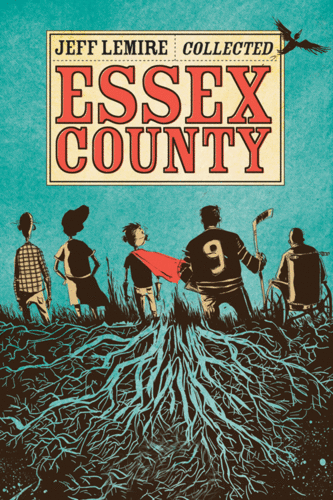 But it was Jeff Lemire’s Essex County that gets my gold star of approval this weekend. While invoking familiar Canadian themes of cold winters, small-town hockey dreams and wheat-covered rural life, he manages to avoid comparison to anyone at all. He gets that Canadian tone just right, without waving flags, sentimentalism, or a tongue in cheek.
But it was Jeff Lemire’s Essex County that gets my gold star of approval this weekend. While invoking familiar Canadian themes of cold winters, small-town hockey dreams and wheat-covered rural life, he manages to avoid comparison to anyone at all. He gets that Canadian tone just right, without waving flags, sentimentalism, or a tongue in cheek.
Each of the three volumes of the novel tell the story of one or more characters from Essex County, Ontario. Each character lives a life interlaced with the others (a small-town given – even the faces and names of the Essex County “short stories” included at the end of the Collected Essex County are familiar, being evidently someone’s uncle, grandfather, or neighbour.) But despite all these connections and overlapping histories the characters are all grappling with crushing loneliness. If there is a Lemire-ian hallmark, it is surely the stark black-and-white full-length panel of a character, alone at a table in a room obviously intended to hold more people. The black shadow cast against two or more walls of the room will reveal some domestic symbol in negative: a cross, a clock. The discomfort of those rooms contrasted with the neutral, trying-to-just-get-by expressions of his (adorable) characters leaves a deep impression. It’s masterful work.
The loose style of Lemire’s art gives the impression of something which has just occurred to him, dashed off in a hurry. But the sketchbooks at the back of the Collected volume tell a much more complete story of drafts, rewrites and thought. The book also does the trick of making you want to spend more time in this world with these – or other – characters. Essex County – Lemire’s version – is a deep world rich with untold stories. The three shorts included in the Collected whets the appetite. That is the mark of a master story-teller.
In other news, is anyone else having a hard time voting for their top-10 Canada Reads title? My instinct is to vote for the book I most want to read, rather than the one I’ve read and liked best. I mean, for Pete’s sake, I don’t want anything I’ve read before on that list. So how could I vote for something I’ve already loved? But then, how essential can I say something is that I’ve never read? Oh well, the saga continues. November 7th (or is it 9th?), you can’t come soon enough.
October 29, 2010
A Busy Weekend in Books
If you aren’t busy enough already shmoozing at the International Festival of Authors, rooting around at the St. Michael’s College Book Sale, or trying to read 40 Canadian novels before November 7th; there’s an extremely exciting alternative available to Torontonians (and her visitors) this weekend: The Toronto International Antiquarian Book Fair.
After a month-long marathon of the University of Toronto’s excellent book sales, book-hunters might be inclined to give this one a miss, but step back for a minute and reconsider. This is not just another book sale. For the first time in fifteen years, Toronto will be hosting some of the biggest and best rare and antiquarian book dealers in the English-speaking world in one spot, and attempting to pull off a show that compares with the excellent New York and Boston International fairs. This is a significant step above the lack-luster local Toronto Book Fair & Paper Shows.
Pre-register: this will get you a coupon for $5 the entrance fee, bringing it down to a very reasonable $10 for unlimited access for the whole three days of the show (October 29th, 30th & 31st). Roughly 50 dealers are scheduled to be showing there wares at the cozy Metro Toronto Convention Centre site. Among these will be the excellent and approachable local dealers like London, Ontario’s Attic Books and Toronto’s own (organizing force) Contact Editions; as well as big International names like Baltimore’s Kelmscott Bookshop and Maggs Brothers of London.
While firms like Maggs and Adrian Harrington can be reasonably counted on to bring some high-visibility (and high-priced) rarities, don’t think this is just a show for established collectors with deep pockets. The promises of “something for everyone” are likely to be well-founded. I’ve always loved looking through Attic Books’ reasonably-priced early-20th century children’s books, or David Mason‘s specialty, the “1st Canadian editions” of important works. While a show like this isn’t for bargain-hunting cheap used copies of paperbacks, you can still find some under-appreciated treasures in the $10-$50 range. Furthermore who wouldn’t want to go see some of the higher-profile books or documents? I might not be able to afford a $275,000 map, but if I should be so lucky, I’d love to glimpse one.
For the amateur collector, this is also an excellent opportunity to approach dealers who don’t keep open shops and sign up to receive their catalogues. I don’t think I’m the only person who reads catalogues for fun: they’re a treasure trove of bibliographical information, a good way to make wish-lists and the best way to get an idea of what books cost on the market. The catalogues themselves are also frequently beautiful things. See the wonderful offerings from Oak Knoll or Roger Gaskell as examples. You’ll never wonder why so many people collect 18th century scientific treatises ever again.
For full details, visit the Toronto International Antiquarian Book Fair’s website.
October 25, 2010
All complaints aside, I’m still excited…
…about the Canada Reads “top 40” to be announced Thursday! In the end I folded and submitted a recommendation against my better judgement (it was a past Canada Reads winner, but given I suspect MANY past Canada Reads winners will be on the list, I’d like one on there that actually feels “essential”, to me). The final list will be, I suspect, a bit of a Janus, with half the list being over-read, popular books the likes of Book of Negroes and Three Day Road, and the other half the product of write-in campaigns organized by enterprising or beleaguered authors. And honestly, that’s not a bad mix. If it makes it that way into the final five, we’ll have a fun little reading list.
I am nursing a little wish-list. Books I’d like to read, but in all honesty probably won’t get to anytime soon if they don’t make the Canada Reads cut. The sad truth is that for all my whining, I’ve actually read very little “recent” Canadian literature – not even the big sellers. So with no further ado, here is my top-5 dream-list!
Canada Reads 2011 (If Charlotte Got To Choose)
1. Three Day Road by Joseph Boyden (I know, I know…)
2. DeNiro’s Game or Cockroach by Rawi Hage (I’m not picky.)
3. Blackstrap Hawco by Kenneth J. Harvey (“epic”, “historical” and an Atlantic Canada Reads nod? I’m in!)
4. The Best Laid Plans by Terry Fallis (I need to laugh now and again, by god.)
5. Elle by Douglas Glover (More history – this time with added feminism!)
***
I’ll have to hold out until next year to get my fix of older titles. I was so hoping to see certain names on a Canada Reads list — those authors have the misfortune not to have published anything major in the last ten years. Canada Reads panelists of the future, how I hope you’ll Google me…
Canada Reads 2012 (If Charlotte Got To Choose)
1. The Tin Flute by Gabrielle Roy
2. Anything by Josef Škvorecký (Swell Season? Bass Saxophone? Two Murders in my Double Life?)
3. Whiteoaks of Jalna by Mazo de la Roche (Tell me a 16-book Canadian soap opera from the 1930s wouldn’t be dead fun to read.)
4. Autobiography of Red by Anne Carson (Poetry, queer lit, historical fantasy and international cred all in one.)
5. Dreams Underfoot by Charles de Lint (One of his best, I think – short stories. Pretty please?)
***
Good luck to everyone tomorrow!
October 22, 2010
Dear Publishers: It’s called a “slipcase”.
 I’m thrilled to death that publishers are getting behind fancy private library editions; big, beautiful hardcover tomes for display or general celebration of bookness. We’ve had a particularly meaty month at my bookstores – doorstoppers are coming fast and furious. Northwestern University Press has published an all-in-one edition of Dante’s Divine Comedy, translated by the ubiquitous Burton Raffel. Yale’s Autobiography of Mark Twain – volume ONE of THREE – weighs in at about 700 pages. We continue to sell out of copies of Joseph Frank’s 1000-page abridged (from 2500 pages) edition of Dostoevsky: A Writer in His Time.
I’m thrilled to death that publishers are getting behind fancy private library editions; big, beautiful hardcover tomes for display or general celebration of bookness. We’ve had a particularly meaty month at my bookstores – doorstoppers are coming fast and furious. Northwestern University Press has published an all-in-one edition of Dante’s Divine Comedy, translated by the ubiquitous Burton Raffel. Yale’s Autobiography of Mark Twain – volume ONE of THREE – weighs in at about 700 pages. We continue to sell out of copies of Joseph Frank’s 1000-page abridged (from 2500 pages) edition of Dostoevsky: A Writer in His Time.
I love big books, I do. I have a probably unhealthy attraction to works that exceed 500 pages; the more the merrier. But if I may – as a bookseller and a collector – make a suggestion? These books look lovely sitting flat on a table, but as time passes they inevitably make their way to shelves where they must stand upright, or into paperback editions where they are nearly as thick as they are tall. They puff-up, tilt and sag. The Pevear and Volokhonsky War and Peace published by Knopf published in 2007 is probably a case in point – in paperback, the book inevitably looks old and used after a mere two weeks on the shelf. It is too big. The binding – especially in paperback – can’t hold shape with so many pages.

This is an easily remedied problem. It’s called a slipcase. You’ve seen them before, a nice cardboard sleeve that hugs two or more volumes together in one tight box. Penguin released a beautiful trade version of The Arabian Nights translated by Lyons & Irwin in 2008 which housed three hardcovers in one slipcase. See how manageable each volume is? No slipping, sliding or flip-flopping around. No puffy, humidity-soaked pages or disintegrating “perfect” binding. And one wide canvas for all your design needs!
You can have your cake and eat it too: all-in-one editions without asking one binding to hold all those pages in one. And wouldn’t it be nice? A 3-volume slipcased edition of Vikram Seth’s A Suitable Boy? Davies’ Deptford Trilogy? Penguin, please, bloody Clarissa? We will all thank you for it.
